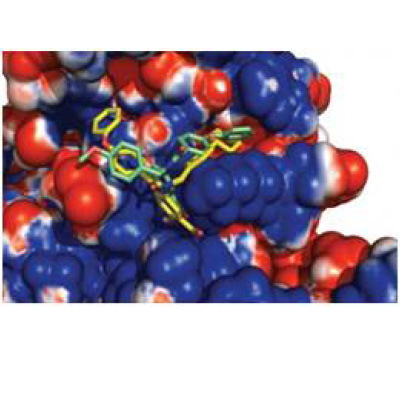
12MB098 STAT3: STAT3 Dimerization Inhibitors
This technology is a novel small molecule inhibitor of STAT3 dimerization and activation, as the physical binding of active STAT3 proteins to each other is critical for cancer cell signaling and growth. Our lead compound blocks STAT3 binding in vitro, decreases the amount of STAT3 in the nucleus of cancer cell lines, and inhibits the growth of cancer cell lines. This direct inhibitor of STAT3 is different from the JAK2 kinase inhibitors that are indirect inhibitors of STAT3. One JAK2 kinase inhibitor has been approved and at least two more are in Phase 3 clinical trials. The targeted STAT3 dimerization inhibitors may prove superior to the indirect STAT3 inhibitors in terms of efficacy and fewer side effects.
COMMERCIAL OPPORTUNITY
- STAT3 is overactive in many cancers, such as breast, lung, prostate, colon, brain, pancreas, head and neck, melanoma, leukemia, multiple myeloma and lymphoma. Overactive STAT3 signaling has been associated with tumorigenesis, metastasis, and poor prognosis, suggesting numerous potential therapeutic opportunities.
- The market for STAT3 inhibitors is attractive, as evidenced by the indirect STAT3 inhibitors (JAK2 kinase inhibitors) either approved or in the clinic. The JAK2 kinase inhibitor Ruxolitinib (marketed as Jakofi from Incyte) is approved for myelofibrosis, a type of bone marrow cancer. Other JAK2 inhibitors in the clinic include Pacritinib (Baxter and Cell Therapeutics) and Momelotinib (Gilead) that are in Phase 3 trials for myelofibrosis.
- Clinical trials for the JAK2 inhibitor Fedratinib (Sanofi) were recently ended after cases of Wernicke's encephalopathy were reported in patients treated with the drug. Targeted STAT3 dimerization inhibitors may have fewer side effects because STAT3 is a downstream target of JAK2.
TECHNOLOGY
In fluorescence polarization dimerization assays, our lead compound inhibited Signal transducer and activator of transcription 3 (STAT3) binding to its phosphorylated target in vitro with an IC50 value of approximately 13.5μM. In cell culture assays with breast and lung cancer cells, the lead compound decreased the amount of active STAT3 in the nucleus by approximately 70% within 4hrs of treatment. At a dose of 200μM, it also inhibited growth of breast and lung cancer cell lines with overactive STAT3 by approximately 70%, but minimally (approximately 20%) inhibited growth of breast, lung, and kidney cells with normal STAT3 levels. These data indicate that our small molecule is an attractive targeted compound that could be effective against a wide range of cancers with overactive STAT signaling, while leaving normal cells largely unaffected. Animal studies are being planned.
PUBLICATION/PATENT
- X. Zhang et al., Cancer Res 2013;73:1922-1933
- PCT patent application filed on 10/30/2013 for Drs. Sebti, N. Lawrence, and H. Lawrence
The Innovation Office
Innovationmarketing@Moffitt.org
(813) 745-6828

